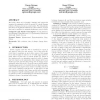56 search results - page 1 / 12 » Microscale evolution of web pages |
129
Voted
WWW
2008
ACM
16 years 1 months ago
2008
ACM
We track a large set of "rapidly" changing web pages and examine the assumption that the arrival of content changes follows a Poisson process on a microscale. We demonst...
133
click to vote
JCDL
2011
ACM
14 years 3 months ago
2011
ACM
A pattern is a model or a template used to summarize and describe the behavior (or the trend) of a data having generally some recurrent events. Patterns have received a considerab...
105
click to vote
PODS
2006
ACM
16 years 13 days ago
2006
ACM
The link structure of the Web can be viewed as a massive graph. The preferential attachment model and its variants are well-known random graph models that help explain the evoluti...
LAWEB
2003
IEEE
15 years 5 months ago
2003
IEEE
This paper expands on a 1997 study of the amount and distribution of near-duplicate pages on the World Wide Web. We downloaded a set of 150 million web pages on a weekly basis ove...
103
Voted
WWW
2005
ACM
16 years 1 months ago
2005
ACM
Web pages contain a combination of unique content and template material, which is present across multiple pages and used primarily for formatting, navigation, and branding. We stu...

